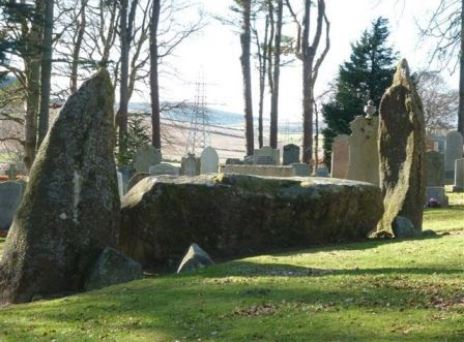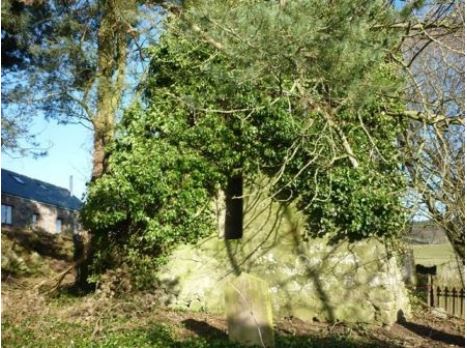Article 6 - St Nidan, St Colm, St Lesmo
and St Marnoch
Article 6 - St Nidan, St Colm, St Lesmo
and St Marnoch
The four saints St Nidan , St Colm , St Lesmo and St Marnoch are the last and among the least well known in our area, but they must be referred to because their names appear on maps etc.. This article will deal with them before trying to sum up what all the articles have achieved.
St Nidan – Site of Church in Midmar (Grid Ref NJ 702059)
Not many of us will have heard of St Nidan, so who was he? The records such as they are have him as a Welsh priest who lived in the 7th to 8th century and came to Scotland with St Kentigern and then came north to Aberdeenshire with St Finan. We met St Finan when looking at the church at Migvie and concluded that there was no evidence that St Finan ever went to Migvie. We must come to the same conclusion about St Nidan ever having been to Midmar, but the stories abound. Baring-Gould in The lives of the British Saints has him coming to Scotland as one of 665 monks who accompanied St Kentigern, and to have made a foundation at Midmar.

Let us suppose for a moment that that did happen. Where might he have made his foundation. Not, I think on the site of the ruined medieval church, but rather about half a mile to the north where there still stands the Midmar recumbent stone circle. This is where the centre of habitation and activity would have been in that area, and the speculation is that that is where Nidan would have made his foundation. It is in fact in the graveyard of the modern church which is post Reformation, built in 1797. At some time after its foundation the original church was replaced by what is now the ruined medieval church down the hill where it became part of a Norman settlement with Cunningar Motte and then in the 18th century it was moved up the hill again to its present site. In medieval times, the church was definitely dedicated to St Nidan. There is another dedication to St Nidan at the former church at the Doune of Invernochty, Strathdon, and this is another case where the dedications to St Nidan at these two churches are the only evidence of the saint in our area.
St Colm – Site of St Colm’s Well (Grid Ref NO 494 881)
As I have said before, sometimes the most compelling evidence of a saint’s presence here is his name on a map, and even then it is really only evidence of a folklore tradition. In the case of St Colm, what we have is a well near the summit of Gannoch on the Firmounth road between Tarfside and Glentanar which has been named St Colm’s Well for centuries, and which was marked in the 19th century by Sir William Cunliffe Brookes, the owner of Glentanar Estate by a pink granite stone enigmatically inscribed “Well Beloved” and with a cross in the middle. So who was St Colm? Fenton Wyness places St Colm as a follower of St Ninian and thinks that he came to Deeside in the 5th century. This view is discredited now and some writers confuse him with St Columba, with whom he shares his name. Other writers associate St Colm with St Drostan and St Fergus, and there are certainly a number of dedications to St Colm in Buchan, notably at Oyne, Daviot and Monymusk. However our interest in him is generated by the original dedication to him at Birse Kirk, which became obscured and forgotten when the dedication was replaced in medieval times by one to St Michael. However, the well at Gannoch remained a place of pilgrimage for many years, and if indeed the Firmounth was the track on which St Colm travelled to Deeside, then the first place he would come to in Deeside would have been Birse, and is a likely place for him to have made a foundation.
St Lesmo – Site of Hermits Well in Glentanar (Grid Ref NO 447 935)
Two buildings near Aboyne bear St Lesmo’s name. The more notable is St Lesmo Chapel near Glentanar House. It was built by Sir William Cunliffe Brookls in 1872. St Lesmo is said to be the Holy Hermit who lived in Glentanar over 1000 years ago and to whom the chapel is dedicated. The other building is the former Rectory for St Thomas’ Episcopal Church Aboyne, known as St Lesmo Towers. No literature on Saints gives any additional information, but the OS map of Glentanar shows a “Hermits Well” at the above Grid Ref Number.
St Marnoch – Site of St Marnoch’s ruined Church (Grid Ref NJ 550 097)

Little is known about St Marnoch, even in the town Kilmarnock where he is said to have founded a church in the 7th century. Catholic Online has him as an Irish bishop and disciple of St Columba who died at Annandale and is revered in the Scottish Borders.
Fenton Wyness says he founded a church in the ancient parish of Inchmarnoch which subsequently merged with the neighbouring parishes of Aboyne and Glentanar but quotes no source. He also states that the ford over the Dee at Dalwhing just west of Aboyne used to be called Marnoch’s Ford, but I can find no such name on a map. However about two kilometres north along the road from Corse Castle towards Alford and near the farm of Upper Leochel stands the ruin of a Church marked on the OS map as “St Marnoch’s Church (Remains of)”. Not much of it remains other than the West gable, and that is covered in Ivy. It has however been a substantial church in its day, but it is not very clear when that day was. It does not appear on Ian B Cowan’s list of Medieval churches in the Diocese of Aberdeen, which suggests a post Reformation date.
© Hugh Cochran 2012
Discover more….
